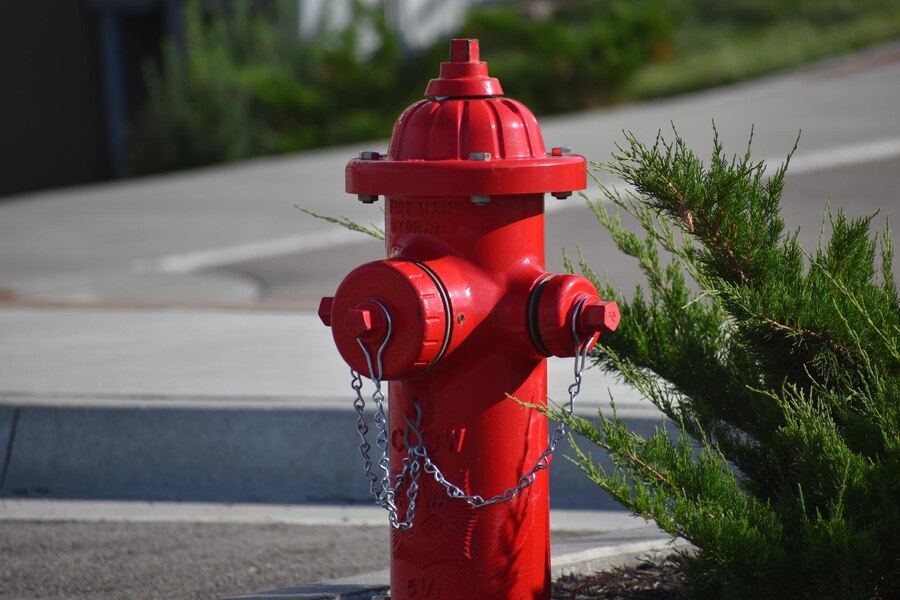Fire hydrant maintenance is a crucial responsibility for property owners, ensuring the safety and preparedness of their premises in the event of a fire. Proper maintenance complies with legal requirements and guarantees the hydrant’s functionality when needed most. This guide delves into the essential aspects of maintaining fire hydrants, from understanding their components and conducting regular inspections to addressing common issues and keeping detailed maintenance records. Property owners can ensure their fire hydrants are always in optimal condition by following these guidelines.
Understanding Fire Hydrant Components
Understanding the critical components of a fire hydrant is essential for effective maintenance. A typical fire hydrant consists of several critical parts, including the bonnet, which covers the operating mechanism, and the upper barrel, which connects to the bonnet and houses the operating nut. The lower barrel extends underground, connecting to the main water supply. Inside, the valve seat controls water flow, and the nozzle or outlets allow firefighters to connect hoses. Each part is vital in ensuring the hydrant functions correctly during emergencies.
Regular inspections should focus on these components to identify any signs of wear or damage. The bonnet and nozzles must be free of obstructions, and the valve seat should seal properly to prevent leaks. Understanding these elements helps property owners address minor issues before they escalate, ensuring the hydrant remains reliable and ready for use.
Legal and Safety Requirements
Complying with legal and safety requirements regarding fire hydrant maintenance is paramount for property owners. Here are essential regulations and guidelines to follow:
- Regular Inspections: Most local jurisdictions require fire hydrants to be inspected at least once a year. These inspections ensure the hydrant is operational and meets safety standards.
- Flow Testing: Regular flow tests, typically mandated annually, measure the water pressure and flow rate to ensure the hydrant can supply adequate water during a fire emergency.
- Accessibility: Fire hydrants must remain unobstructed and accessible at all times. This includes keeping them clear of vegetation, debris, and parked vehicles.
- Proper Marking and Signage: Hydrants must be marked and visible, often with reflective paint or signage, to ensure firefighters can quickly locate them during an emergency.
- Record Keeping: Detailed records of all inspections, maintenance, and repairs must be maintained. These records are crucial for demonstrating compliance with regulations and tracking the hydrant’s performance over time.
Regular Inspection and Testing
Regular inspection and testing of fire hydrants are vital to ensure their proper functionality and reliability. Here are the critical aspects of this maintenance task:
- Frequency of Inspections and Tests: Fire hydrants should be inspected and tested annually. Some local regulations may require more frequent checks, especially in high-risk areas. Regular inspections help identify potential issues before they become serious problems.
- Checklist for Routine Inspections: Several components must be evaluated during inspections. This includes checking for physical damage, ensuring the bonnet and nozzles are secure and free from obstructions, verifying that the hydrant is easily accessible, and inspecting the surrounding area for any signs of leaks or water accumulation. The operating nut should be turned to ensure it moves freely, and lubrication may be applied if necessary.
- How to Perform a Flow Test: Flow testing is crucial to measure the hydrant’s water pressure and flow rate. Attach a flow gauge to the nozzle, open the hydrant fully, and record the pressure readings to conduct a flow test. This data helps determine if the hydrant can supply adequate water during a fire emergency. Any deviations from the expected performance should be addressed immediately to ensure the hydrant’s effectiveness.
Common Issues and Troubleshooting
Fire hydrants, like any mechanical system, can develop issues over time. Identifying and addressing these common problems promptly is crucial for maintaining their functionality. Here are some frequent issues and troubleshooting tips:
Identifying Signs of Wear and Tear: Regular inspections may reveal signs of wear and tear, such as rust, corrosion, or physical damage to the hydrant’s exterior. Look for cracks in the casing, loose bolts, or peeling paint. These signs indicate the need to maintain or replace affected parts to prevent more severe issues.
How to Address Leaks, Corrosion, and Blockages
- Leaks: Leaks can occur at the connections, valves, or seals. If you notice water pooling around the base of the hydrant or continuous dripping from the nozzles, it may indicate a leak. Tighten loose connections, replace worn-out seals, or call a professional if the problem persists.
- Corrosion: Corrosion is common in older hydrants, particularly metal ones. Regularly clean and apply anti-corrosive coatings to prevent rust buildup. Replacing the affected parts or the entire hydrant may be necessary if corrosion is extensive.
- Blockages: Debris, sediment, or ice can block water flow in a hydrant. Remove the nozzle caps and flush out the hydrant by opening it fully to clear blockages. Ensure the hydrant is winterized to prevent freezing and subsequent blockages during cold weather.
When to Call a Professional: Some issues may require more than simple DIY fixes. If you encounter problems such as significant leaks, persistent corrosion, or complex mechanical failures, it’s best to contact a professional maintenance service. Professionals have the expertise and tools to perform in-depth repairs and restore the hydrant to optimal condition.
Seasonal Maintenance Tips
Seasonal maintenance is crucial for keeping fire hydrants in optimal working condition throughout the year. Here are some essential tips for both winter and summer maintenance:
Winterization Steps to Prevent Freezing
- Drain the Hydrant: Ensure it is fully drained after testing or using it to prevent water from freezing inside. Frozen water can cause severe damage to the hydrant’s internal components.
- Apply Insulation: Wrap the hydrant with insulation materials, such as foam or thermal blankets, to protect it from frigid temperatures. This helps maintain the internal temperature and prevents freezing.
- Use Anti-Freeze Solutions: In frigid winters, consider using anti-freeze solutions designed explicitly for hydrants. These solutions can help prevent water inside the hydrant from freezing.
- Check Hydrant Caps and Valves: Ensure all caps and valves are tightly sealed to prevent water from entering and freezing. Replace any worn-out seals or gaskets to maintain a secure seal.
- Clear Snow and Ice: Regularly clear snow and ice around the hydrant to ensure it remains accessible during emergencies. Snow buildup can hide the hydrant and delay response times.
Summer Maintenance for Optimal Performance
- Inspect for Leaks and Corrosion: Summer is an ideal time to conduct thorough inspections for leaks and corrosion. Warm weather makes it easier to perform repairs and apply anti-corrosive coatings.
- Lubricate Moving Parts: Lubricate the operating nut and other moving parts to ensure they function smoothly. Proper lubrication prevents rust and wear caused by increased usage during the summer months.
- Clear Vegetation: Trim any overgrown vegetation around the hydrant to ensure it remains visible and accessible. Plants and bushes can obstruct access and hinder firefighting efforts.
- Perform Flow Tests: Conduct flow tests to ensure the hydrant provides adequate water pressure and flow. Summer is a good time for these tests, as the weather conditions are more favorable.
- Paint and Mark: Repaint the hydrant if necessary and ensure it is marked with reflective paint or signage. This helps firefighters quickly locate the hydrant, especially in low visibility conditions.
Documentation and Record Keeping
Accurate documentation and records are essential for effective fire hydrant maintenance. Detailed records of all inspections, maintenance activities, and repairs provide a comprehensive history of each hydrant’s condition and performance. These records help property owners track when the last inspection was performed, what issues were identified, and what corrective actions were taken, ensuring that no maintenance tasks are overlooked.
Proper record-keeping also ensures compliance with local regulations and standards. In the event of an emergency or an audit, having well-documented maintenance logs can demonstrate diligence and adherence to safety requirements. Additionally, these records can help identify recurring issues, allowing for proactive measures to prevent future problems and maintain the hydrant’s reliability and functionality.
Professional Maintenance Services
Hiring professional maintenance services for fire hydrants offers numerous benefits for property owners. Professionals possess the expertise and specialized equipment to perform thorough inspections, accurate flow tests, and effective repairs. They can identify and address issues that might be overlooked during routine checks, ensuring the hydrants are always in optimal condition.
Moreover, professional services ensure compliance with local regulations and safety standards, reducing the risk of fines or liabilities. They also provide detailed maintenance records, essential for tracking the hydrant’s history and performance. By investing in professional maintenance, property owners can ensure their fire hydrants are reliable, functional, and ready for emergency use, providing peace of mind and enhanced safety for their properties.
Fire Hydrant Replacement and Upgrades
Replacing or upgrading fire hydrants is sometimes necessary to ensure optimal performance and compliance with current safety standards. Older hydrants may suffer from corrosion, wear, or outdated designs that limit their effectiveness. Upgrading to modern hydrants can enhance reliability and water flow, which is crucial during fire emergencies.
Replacement is often required if a hydrant is damaged beyond repair or fails to meet regulatory standards. Newer models may offer advanced features like better freeze protection or improved durability. Additionally, upgrading hydrants can be part of broader infrastructure improvements, ensuring the entire fire suppression system is up-to-date. Property owners can enhance fire safety by investing in replacements and upgrades, ensuring efficient and dependable fire hydrant performance.
Fire hydrant maintenance is crucial to property ownership, ensuring safety and compliance with local regulations. Regular inspections, timely repairs, and adherence to seasonal maintenance tips keep hydrants in optimal working condition and ready for emergencies. This guide allows property owners to maintain their fire hydrants effectively and avoid costly issues.
For professional fire hydrant maintenance services, contact IAFF Local 1563 at 410-987-1180. Our experts provide thorough inspections, repairs, and upgrades to ensure your hydrants are always reliable. Protect your property and enhance safety with our trusted services. Call us today!

